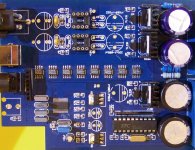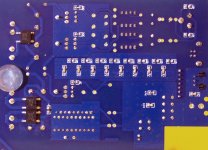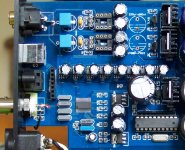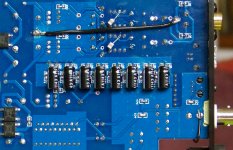Of all the classic Red Book designs I've tried, Naim's TDA1541A/SAA7220 is the one I liked best. There's a reason why they located the 7210/7220/1541 I2S tracelines super close.
Thanks for sharing that pic, an excellent example of sucky power supply layout. Look at the distance between those 3-term regs and the opamps they feed.
Because I've tried NOS in many flavors and colors ... and found it ALMOST universally boring.
I don't think I'm in the minority...)
'Braxy's gonna point out that if you don't need to run at the double F, why would you?
Faster, more noise, more glitches, more clk, more 'straight' edges, ...
Go NOS, compensate for the sin c roll off:
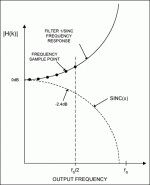
[Best of both worlds, low f and flat FreqResp]
And then rambling T:
RE: Recognising a high quality Non-OS DAC...Part 2 - Thorsten - Digital Drive
Last edited:
'Braxy's gonna point out that if you don't need to run at the double F, why would you?
Now you've pointed that out no need for me to
Faster, more noise, more glitches, more clk, more 'straight' edges, ...
The downsides of oversampling are normally ignored by its proponents. But yep, the more you oversample the greater proportion of time your DAC's output is at the wrong value. Perhaps Tam Lin will contribute at this point and assert that because with oversampling the step size between two output samples gets smaller then the settling time improves. Probably it does but I've yet to see evidence that it gets twice as fast with step sizes half as big. If anyone has such evidence, please do share it.
What's funny ....
And I SWITCHED to using that topo -- like what I heard .... and never went back:
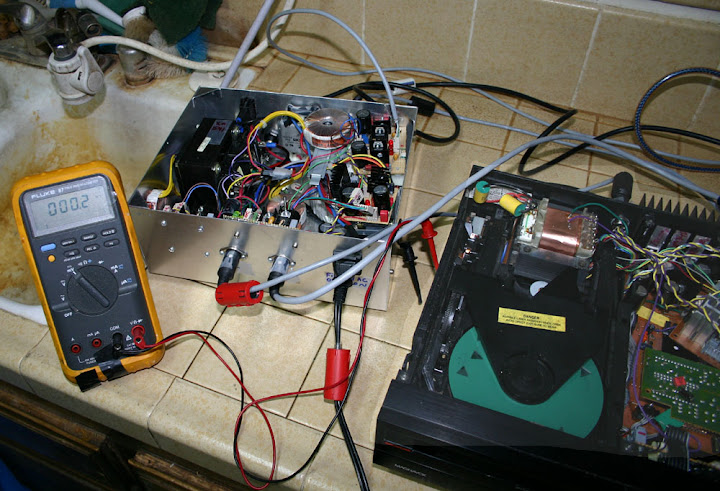
But all you DIY folks want to see somethin' real funny ...
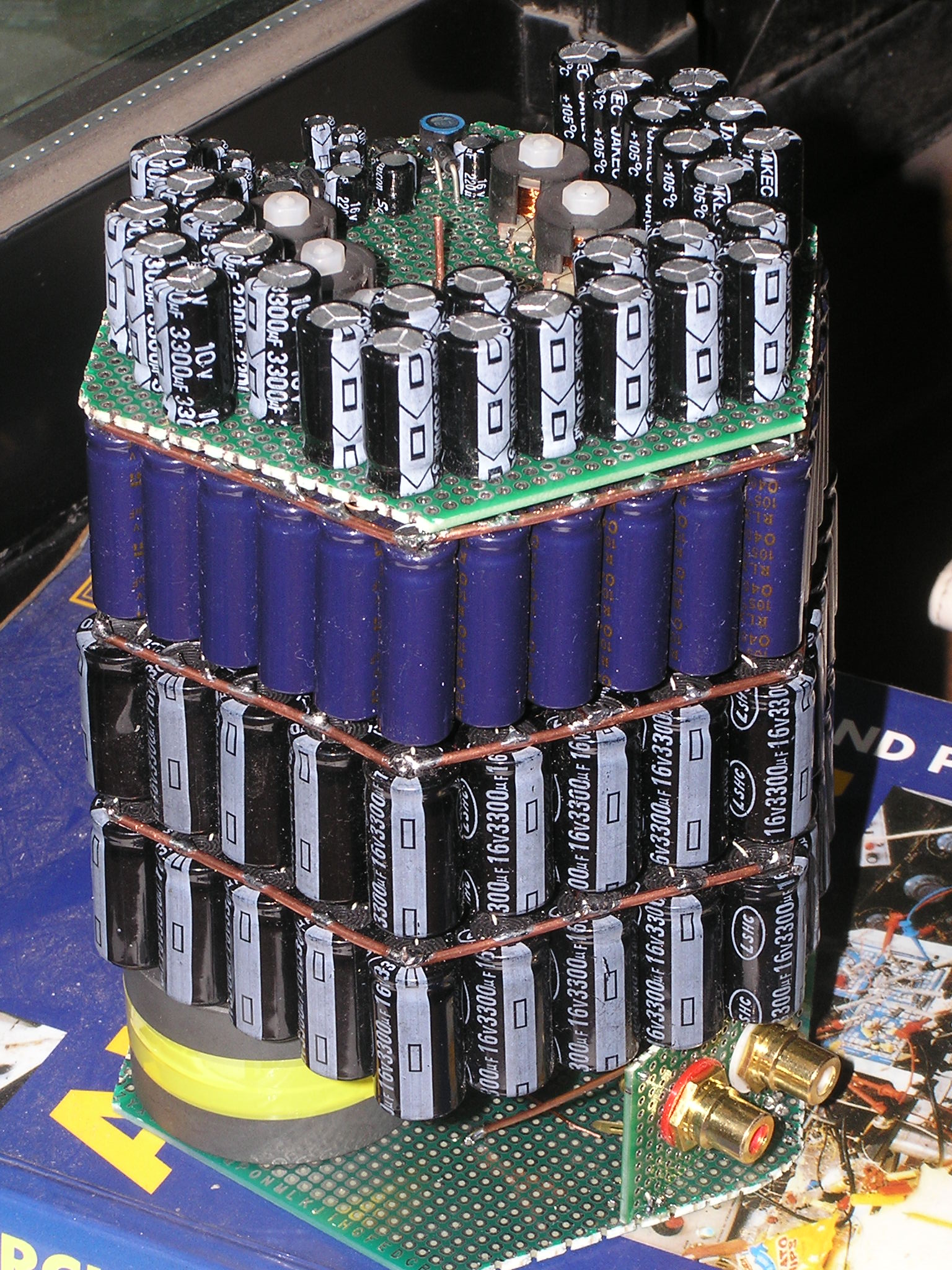



!!!!LOL!!!!!
In fact, you cracked up these guys ...
https://www.youtube.com/watch?v=IDDEpnjgTyw
Recall that Naim also uses OUTBOARD power supplies for CDPs, etc.:Thanks for sharing that pic, an excellent example of sucky power supply layout. Look at the distance between those 3-term regs and the opamps they feed.
An externally hosted image should be here but it was not working when we last tested it.
And I SWITCHED to using that topo -- like what I heard .... and never went back:

But all you DIY folks want to see somethin' real funny ...


!!!!LOL!!!!!
In fact, you cracked up these guys ...
https://www.youtube.com/watch?v=IDDEpnjgTyw
Recall that Naim also uses OUTBOARD power supplies for CDPs, etc.
So you're saying because Naim does something, it has to be the bees knees?
And I SWITCHED to using that topo -- like what I heard .... and never went back:

So now you use external PSUs on all your DACs?
Incidentally what's the point of clogging up this thread with reposted pics from my blog? Especially the same pic more than once? What gives?
It was out of topic since the very begining, what was the point? I wonder if I've done wrong something; I'm no engineer, just looking for what's in the title of the thread, that very NOS DAC.
Please PM me if there is something personal against me, others don't have to suffer our pathetic stories and over-reactions on just nothing. Really don't see where it's from or where it's going...
Please PM me if there is something personal against me, others don't have to suffer our pathetic stories and over-reactions on just nothing. Really don't see where it's from or where it's going...
Remove and clean.
Here is my PCB, ready for some caps upgrade.
Matt, I can tell you the board is easy to work with.
I'll fit in what I have, Rubycon ZLG/ZLH, Nichicon HV, 10µF/35V X7R (will stack 2) and 75R BNC, OPA602 and LM6171 opamps. I had to buy the advised 15.000µF caps wich I don't have at home nor office. Cheap enough BTW. Opamps may need better choice of surrounding parts than the one really on the PCB.
Some questions still;
The analog supply for the CS8416 is pointed as critical for jitter in the datasheet, so that 10µF cap is worth being upgraded with something like an OsCon?
Each TDA1387 chip seems to have a 100nF cap on its 4/5 pins, under the PCB and still on mine, +5v supply, again something to be gained like the use of BG without such 100nF at each chip supply pins? That was done in the hot days of CDPs...
What about the sound of the output caps? Worth upgrading or decent enough (knowing the Epcos MKT in my Tripath amps I think they are good!), BTW I'll increase them up to 4.7µF as my preamplifier input Z is 10K...wich leads to a new question, what is the output impendence of this DAC? Are the opamps to be chosen with that in mind? Or with caps in minds? Do your bias at output (prior to output caps?) with DC is doing the magic on the caps (DC biased caps to avoid polarity change hysteresis?).
Will report after mods and opamp swap (including OEM LT1028).
Here is my PCB, ready for some caps upgrade.
Matt, I can tell you the board is easy to work with.
I'll fit in what I have, Rubycon ZLG/ZLH, Nichicon HV, 10µF/35V X7R (will stack 2) and 75R BNC, OPA602 and LM6171 opamps. I had to buy the advised 15.000µF caps wich I don't have at home nor office. Cheap enough BTW. Opamps may need better choice of surrounding parts than the one really on the PCB.
Some questions still;
The analog supply for the CS8416 is pointed as critical for jitter in the datasheet, so that 10µF cap is worth being upgraded with something like an OsCon?
Each TDA1387 chip seems to have a 100nF cap on its 4/5 pins, under the PCB and still on mine, +5v supply, again something to be gained like the use of BG without such 100nF at each chip supply pins? That was done in the hot days of CDPs...
What about the sound of the output caps? Worth upgrading or decent enough (knowing the Epcos MKT in my Tripath amps I think they are good!), BTW I'll increase them up to 4.7µF as my preamplifier input Z is 10K...wich leads to a new question, what is the output impendence of this DAC? Are the opamps to be chosen with that in mind? Or with caps in minds? Do your bias at output (prior to output caps?) with DC is doing the magic on the caps (DC biased caps to avoid polarity change hysteresis?).
Will report after mods and opamp swap (including OEM LT1028).
Attachments
The analog supply for the CS8416 is pointed as critical for jitter in the datasheet, so that 10µF cap is worth being upgraded with something like an OsCon?
Back in the days when I was modding DAC-AHs, I did all kinds of things to the digital part around the receiver chip. I so far haven't noticed any audible effects from jitter or improvements in jitter. They may be there, just to my ears they're not the lowest hanging fruit. For example I don't notice a difference going between being fed from my CD player over S/PDIF and other DACs where I feed direct I2S from my QA550. By all means do it and report back - maybe I'll become a jitter freak in future
Since I noticed adding lots more capacitance (I'm up to 105,000uF now) makes a difference to the bass, I don't much care where I stick the extra caps. At LF, series inductance is having a negligible effect on the supply impedance so caps can be a bit remote from the chips they're decoupling.Each TDA1387 chip seems to have a 100nF cap on its 4/5 pins, under the PCB and still on mine, +5v supply, again something to be gained like the use of BG without such 100nF at each chip supply pins? That was done in the hot days of CDPs...
My active speakers are AC coupled so I deleted the caps when I added the LC output filter. There was a distinct improvement but I assumed it was caused by the presence of the filter not the removal of the capsWhat about the sound of the output caps? Worth upgrading or decent enough (knowing the Epcos MKT in my Tripath amps I think they are good!), BTW I'll increase them up to 4.7µF as my preamplifier input Z is 10K...
In stock form its 220ohms - there's a series resistor on the opamp output of this value. I think that's a bit high myself - since I now have an LC filter after the opamp its gone down to around 10ohms at LF (the DCR of the 10mH inductor).wich leads to a new question, what is the output impendence of this DAC?
All opamps I've come across have very low output impedance (due to lots of feedback) so I don't think any differences in Zout are significant in this circuit. No I haven't bothered with biassing caps.
@matt - next time my DAC's on the bench for mods I'll have a look at the I2S lines.
Last edited:
Easy experiment:
Get a test CD (or test signal files) and run them thru that 8x parallel TDA1387.
Record measurements (screen capture) o'scope and spectrum analyzer traces.
Perform usual SUBJECTIVE tests using your favorite music/movie tracks. Record results.
NOW ... remove all but ONE of the parallel TDA1387s. And REPEAT the above experiment.
Report your findings below....
(Oh, and uh, one more thing...)
Get a test CD (or test signal files) and run them thru that 8x parallel TDA1387.
Record measurements (screen capture) o'scope and spectrum analyzer traces.
Perform usual SUBJECTIVE tests using your favorite music/movie tracks. Record results.
NOW ... remove all but ONE of the parallel TDA1387s. And REPEAT the above experiment.
Report your findings below....
(Oh, and uh, one more thing...)
Good DAC, compared to shop's gear.
Hi,
we've modded my friend's one, and then tried the OEM LT1028; no more usable because we got loud noises when music was at lower volume. I guess the removed 2.2nF caps are the curse, else what can lead an op amp to go crazy?
BTW, LM6171 does sounds nice. Less dynamic than the LT208 (prior to problem and when music is played), but more balanced, the LT1028 being a bit on the cold side. The very first hour with the LM6171 (and new caps mainly I guess) it sounded bad, really bad, but after we played some music and went there later we did a simple comparaison, one input of the amp to the DAC fed with a CDP's SPIDF, the same CDP analog output on another input of the amp.
Just the time to switch source to compare the same records. Almost impossible but it sounded almost the same, no way to say wich is wich in blind test, maybe with a tiny bit more space to the CDP, but impossible to see beside doing a source swith with the same record played. Not in real life I mean. And that very player (modded...) was brought to a high-end shop in town and needed a new player over 2500€ to do better... that are facts with outside people having no commercial input there.
Here is mine today, now burining in (as we seen that terrific change within hours), will play my music on it later. I can say that OPA602 works in flawlessly and I've put IC socket parts in the 2.2nF holes in case I need them back.
So far so good!
Hi,
we've modded my friend's one, and then tried the OEM LT1028; no more usable because we got loud noises when music was at lower volume. I guess the removed 2.2nF caps are the curse, else what can lead an op amp to go crazy?
BTW, LM6171 does sounds nice. Less dynamic than the LT208 (prior to problem and when music is played), but more balanced, the LT1028 being a bit on the cold side. The very first hour with the LM6171 (and new caps mainly I guess) it sounded bad, really bad, but after we played some music and went there later we did a simple comparaison, one input of the amp to the DAC fed with a CDP's SPIDF, the same CDP analog output on another input of the amp.
Just the time to switch source to compare the same records. Almost impossible but it sounded almost the same, no way to say wich is wich in blind test, maybe with a tiny bit more space to the CDP, but impossible to see beside doing a source swith with the same record played. Not in real life I mean. And that very player (modded...) was brought to a high-end shop in town and needed a new player over 2500€ to do better... that are facts with outside people having no commercial input there.
Here is mine today, now burining in (as we seen that terrific change within hours), will play my music on it later. I can say that OPA602 works in flawlessly and I've put IC socket parts in the 2.2nF holes in case I need them back.
So far so good!
Attachments
we've modded my friend's one, and then tried the OEM LT1028; no more usable because we got loud noises when music was at lower volume. I guess the removed 2.2nF caps are the curse, else what can lead an op amp to go crazy?
You could be right on that - I've never tried the LT1028 in that position but when I had my AD1955 on the bench, the I/V initially came with NE5532 and that would indeed go crazy with zero feedback capacitance. And yeah it was only noticeable at very low levels (and digital silence) - the sound was like FM birdies. But the sound I liked the best with no feedback capacitance. So if you want to use LT1028 I suggest trying it with a much reduced cap value - 22pF?
Yes I put this down to new caps, have experienced the same that things sound very bad at first.BTW, LM6171 does sounds nice. Less dynamic than the LT208 (prior to problem and when music is played), but more balanced, the LT1028 being a bit on the cold side. The very first hour with the LM6171 (and new caps mainly I guess)...
That's a pretty high recommendation for a sub-$100 DAC. I've looked at your picture - the electrolytics across the 1387s look to be between pin4 and 5 - across the supply. Have you added electrolytics to pin7? To me that's a much bigger improvement than more C on the supply.... it sounded bad, really bad, but after we played some music and went there later we did a simple comparaison, one input of the amp to the DAC fed with a CDP's SPIDF, the same CDP analog output on another input of the amp.
Just the time to switch source to compare the same records. Almost impossible but it sounded almost the same, no way to say wich is wich in blind test, maybe with a tiny bit more space to the CDP, but impossible to see beside doing a source swith with the same record played. Not in real life I mean. And that very player (modded...) was brought to a high-end shop in town and needed a new player over 2500€ to do better... that are facts with outside people having no commercial input there.
Here is mine today, now burining in (as we seen that terrific change within hours), will play my music on it later. I can say that OPA602 works in flawlessly and I've put IC socket parts in the 2.2nF holes in case I need them back.
So far so good!
<edit> Ah I hadn't looked at your second pic - looks like you put the pin7 caps on the bottom. But there's hardly any height available underneath - what values are you using?
Last edited:
I've buzzed out the connectivity of the opamp-DAC interface now. Its using active I/V with the opamp as a transimpedance amp.
https://www.by-rutgers.nl/IV-converter.html
Nice reading showing why LT1028 performs well here.
Looks to be all based on simulation, not listening.
A few years back I spent days trying to find out with my simulator why a smaller cap across the feedback resistor gave improved depth to the soundstage. In the end I gave up. Now I figure its because of something related to the power supply, and very few simulation models model the way an opamp interacts with its power supply.
A few years back I spent days trying to find out with my simulator why a smaller cap across the feedback resistor gave improved depth to the soundstage. In the end I gave up. Now I figure its because of something related to the power supply, and very few simulation models model the way an opamp interacts with its power supply.
So I didn't realize until mentioned in another thread that this DAC is built for 220v mains, and I'm on 110v mains here in the US. Any reason I can't get away with a cheap step-up transformer like this one on Amazon? Long-term plan would be to change the on-board transformers to 110v. Or, maybe I'll get lucky and the existing trannies already have (currently unused) 110v taps?
No updates to this thread in a while, you guys already bored with it and moved on? Or maybe it's so good you're just quietly enjoying it?
I'm waiting on the Taobao agent to finish the domestic order on their side. Then another several weeks for the shipping to USA.
I went ahead and ordered both the fully-built DAC but also the board-only kit. I figured it might be wise to have a spare.
No updates to this thread in a while, you guys already bored with it and moved on? Or maybe it's so good you're just quietly enjoying it?
I'm waiting on the Taobao agent to finish the domestic order on their side. Then another several weeks for the shipping to USA.
I went ahead and ordered both the fully-built DAC but also the board-only kit. I figured it might be wise to have a spare.
- Home
- Source & Line
- Digital Line Level
- TDA1387 x8 DAC: let's check its design, mod it -or not-, play music -or not! :(-
